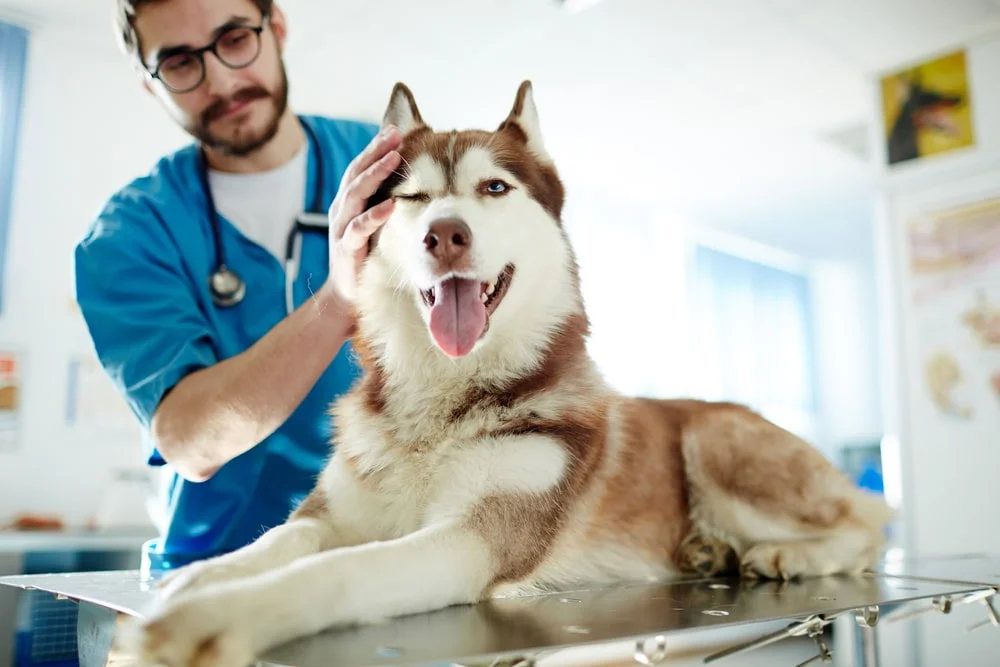PET HEALTH
Leptospirosis in dogs (sometimes called lepto for short) can be a mild or life-threatening bacterial infection, so you may want to know how to spot it and how to prevent it from happening. This guide will help you understand what canine leptospirosis is, as well as its symptoms, how it is diagnosed, treatment plans, and prevention so you can be prepared.
What Is Leptospirosis in Dogs?
Leptospirosis is an infectious disease in mammals caused by the bacteria genus Leptospira, and can cause damage primarily to the liver and kidneys.1 Leptospira bacteria thrive in warm and wet environments which can survive for months in the right conditions.2 If you live in an area that is wet, warm, or gets heavy rainfall, it may be easier for the bacteria to spread and your dog to come into contact with it.
Dogs commonly get infected through standing water or soil contaminated with urine that contains the bacteria.2 Although coming into contact with urine-contaminated food and bedding may also transmit the disease. Wild animals like rodents and raccoons can spread the disease through their urine, bites, or contact with its carcass.3 It can also be spread from one infected dog to another.
The bacteria can enter your dog’s body through their eyes, nose, mouth, or broken skin, attaching to cells that line blood vessels.2 This disease is considered zoonotic, meaning the infection could spread from your dog to you.
Leptospirosis Symptoms in Dogs
The signs of leptospirosis in dogs can vary widely — sometimes it can go undetected while other times it can be life-threatening. Any age, sex, or breed of dog can become infected. Dogs typically present symptoms approximately 1 week after infection.2
Some of the common signs of canine leptospirosis can include:2
- Vomiting
- Diarrhea
- Fever
- Abdominal pain
- Increased urination
- Increased thirst
- Decreased appetite
- Stiffness or soreness
- Weakness or lethargy
Different Leptospira strains can cause different symptoms and diseases in dogs. Some of the more serious symptoms can include:2
- Jaundice
- Dehydration
- Bleeding under the skin
- Red eyes
- Difficulty breathing
- Pulmonary hemorrhage
The stages of leptospirosis in dogs
After initial infection, your dog’s immune system will try to rid their body of the bacteria. If their immune system can’t eradicate the infection, it can spread to different organs and start causing damage.
If your dog’s kidneys are injured by a leptospirosis infection, they may return to normal function but it could possibly develop into chronic kidney disease.1 Liver disease may develop as a result of this kidney injury or it may develop on its own, which could also become a chronic illness.1
Complete recovery after treatment is possible but some dogs may not be so lucky. Unfortunately, lepto can be fatal if enough organ damage has been done or if the ability for blood to clot has been severely affected.2
Diagnosing Canine Leptospirosis
The clinical signs of leptospirosis can be confused with other diseases and conditions since they vary so widely. Veterinarians typically start with blood and urine tests to rule out anything else. Based on those results, they may test for antibodies and conduct a polymerase chain reaction (PCR) test to confirm the genetic presence of Leptospira.2 Vets may also take X-rays to look for internal damage caused by the infection.
Treating Leptospirosis in Dogs
For leptospirosis in dogs, treatment protocol typically consists of antibiotics (usually doxycycline) for at least 2 weeks to eliminate the infection, and could include additional treatments to help support the body’s recovery or treat any damage caused by the infection.2 Dogs may need to be hospitalized to monitor electrolyte levels and provide intravenous (IV) fluids during the initial stage of treatment.2 Since the veterinary care your pet needs for lepto can vary significantly depending on the severity of their case, you may find that it could cost a few hundred to a few thousand dollars to treat it.
During treatment, you may want to keep your dog away from other pets or people to prevent the spread of infection, but they do not need to be isolated.1 This could look like feeding and walking them separately, and giving them a specific spot to lay in while they recover.
Since leptospirosis is zoonotic, avoid bare skin contact with your dog’s urine or blood, and don’t let it get near your eyes, nose, or mouth — this can help prevent the infection from spreading to you.1 You may want to wear rubber gloves when handling anything your dog may have soiled and disinfect these areas until their antibiotic treatment is complete. Common household disinfectants and diluted bleach solutions can typically kill the bacteria.1 Make sure to wash your hands after handling your dog or anything they’ve come into contact with.
Helping your dog recover
Once the infection is gone, your dog’s body may need some help recovering. Depending on the severity of the infection, this may be as simple as letting them rest and keeping up with your veterinarian’s dietary and exercise recommendations. However, for certain cases it could mean long-term treatment for any damage caused. You and your vet can come up with the best plan to help your fur baby recover.
Leptospirosis Prevention
A good way to ensure you and your dog don’t have to experience lepto is by taking preventative measures. Here are some ways you can help prevent infection:2
- Keep your dog protected with an annual leptospirosis vaccine.
- Avoid contact with wildlife and manage any rodent problems.
- Limit exposure to standing water or potentially contaminated soil.
- Avoid instances where coming into contact with contaminated urine is possible.
There’s no way to fully prevent a leptospirosis infection from happening since the vaccine only protects against the four most common strains. You won’t always know what could be contaminated with the bacteria, but taking preventative steps can be less costly than treatment after infection.
Save on Lepto Costs
Whether your dog needs leptospirosis treatment, after-care, or management for the damage caused, vet bills can add up. Investing in a MetLife Pet Insurance policy may be worth it by helping you save on covered pet care expenses. Our dog insurance policies may cover diagnostic testing, hospitalizations, and treatment for your pup with lepto.4 Get your free quote today.


